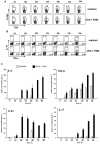C5a receptor-deficient dendritic cells promote induction of Treg and Th17 cells
- PMID: 20017191
- PMCID: PMC3040298
- DOI: 10.1002/eji.200939333
C5a receptor-deficient dendritic cells promote induction of Treg and Th17 cells
Abstract
C5a is a proinflammatory mediator that has recently been shown to regulate adaptive immune responses. Here we demonstrate that C5a receptor (C5aR) signaling in DC affects the development of Treg and Th17 cells. Genetic ablation or pharmacological targeting of the C5aR in spleen-derived DC results in increased production of TGF-beta leading to de novo differentiation of Foxp3(+) Treg within 12 h after co-incubation with CD4(+) T cells from DO11.10/RAG2(-/-) mice. Stimulation of C5aR(-/-) DC with OVA and TLR2 ligand Pam(3)CSK(4) increased TGF-beta production and induced high levels of IL-6 and IL-23 but only minor amounts of IL-12 leading to differentiation of Th cells producing IL-17A and IL-21. Th17 differentiation was also found in vivo after adoptive transfer of CD4(+) Th cell into C5aR(-/-) mice immunized with OVA and Pam(3)CSK(4). The altered cytokine production of C5aR(-/-) DC was associated with low steady state MHC class II expression and an impaired ability to upregulate CD86 and CD40 in response to TLR2. Our data suggest critical roles for C5aR in Treg and Th17-cell differentiation through regulation of DC function.
Conflict of interest statement
Figures





Similar articles
-
IL-6-gp130-STAT3 in T cells directs the development of IL-17+ Th with a minimum effect on that of Treg in the steady state.Int Immunol. 2007 Jun;19(6):695-702. doi: 10.1093/intimm/dxm045. Epub 2007 May 9. Int Immunol. 2007. PMID: 17493959
-
C5a receptor signalling in dendritic cells controls the development of maladaptive Th2 and Th17 immunity in experimental allergic asthma.Mucosal Immunol. 2013 Jul;6(4):807-25. doi: 10.1038/mi.2012.119. Epub 2012 Dec 5. Mucosal Immunol. 2013. PMID: 23212198
-
Absence of signaling into CD4⁺ cells via C3aR and C5aR enables autoinductive TGF-β1 signaling and induction of Foxp3⁺ regulatory T cells.Nat Immunol. 2013 Feb;14(2):162-71. doi: 10.1038/ni.2499. Epub 2012 Dec 23. Nat Immunol. 2013. PMID: 23263555 Free PMC article.
-
FOXP3 and the regulation of Treg/Th17 differentiation.Microbes Infect. 2009 Apr;11(5):594-8. doi: 10.1016/j.micinf.2009.04.002. Epub 2009 Apr 14. Microbes Infect. 2009. PMID: 19371792 Free PMC article. Review.
-
Regulatory T cells and the induction of IL-17.Mucosal Immunol. 2008 Nov;1 Suppl 1:S43-6. doi: 10.1038/mi.2008.51. Mucosal Immunol. 2008. PMID: 19079228 Review.
Cited by
-
Complement C5a induces PD-L1 expression and acts in synergy with LPS through Erk1/2 and JNK signaling pathways.Sci Rep. 2016 Sep 14;6:33346. doi: 10.1038/srep33346. Sci Rep. 2016. PMID: 27624143 Free PMC article.
-
Immunoglobulin G1 and immunoglobulin G4 antibodies in multiple sclerosis patients treated with IFNβ interact with the endogenous cytokine and activate complement.Clin Immunol. 2013 Aug;148(2):177-85. doi: 10.1016/j.clim.2013.05.008. Epub 2013 May 22. Clin Immunol. 2013. PMID: 23770627 Free PMC article.
-
The dual role of complement in cancer and its implication in anti-tumor therapy.Ann Transl Med. 2016 Jul;4(14):265. doi: 10.21037/atm.2016.06.26. Ann Transl Med. 2016. PMID: 27563652 Free PMC article. Review.
-
Complement anaphylatoxins as immune regulators in cancer.Cancer Med. 2014 Aug;3(4):747-58. doi: 10.1002/cam4.241. Epub 2014 Apr 8. Cancer Med. 2014. PMID: 24711204 Free PMC article. Review.
-
Septicaemia models using Streptococcus pneumoniae and Listeria monocytogenes: understanding the role of complement properdin.Med Microbiol Immunol. 2014 Aug;203(4):257-71. doi: 10.1007/s00430-013-0324-z. Epub 2014 Apr 12. Med Microbiol Immunol. 2014. PMID: 24728387 Free PMC article.
References
-
- Köhl J. The role of complement in danger sensing and transmission. Immunol Res. 2006;34:157–176. - PubMed
-
- Gerard C, Gerard NP. C5A anaphylatoxin and its seven transmembrane-segment receptor. Annu Rev Immunol. 1994;12:775–808. - PubMed
-
- Lee H, Whitfeld PL, Mackay CR. Receptors for complement C5a. The importance of C5aR and the enigmatic role of C5L2. Immunol Cell Biol. 2008;86:153–160. - PubMed
-
- Cain SA, Monk PN. The orphan receptor C5L2 has high affinity binding sites for complement fragments C5a and C5a des-Arg(74) J Biol Chem. 2002;277:7165–7169. - PubMed
-
- Okinaga S, Slattery D, Humbles A, Zsengeller Z, Morteau O, Kinrade MB, Brodbeck RM, et al. C5L2, a Nonsignaling C5A Binding Protein. Biochemistry. 2003;42:9406–9415. - PubMed
Publication types
MeSH terms
Substances
Grants and funding
LinkOut - more resources
Full Text Sources
Other Literature Sources
Research Materials
Miscellaneous

